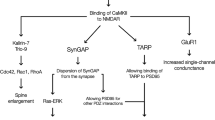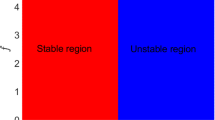Abstract
Long-Term Potentiation (LTP) has three properties: (1) input specificity, (2) cooperativity and (3) associativity. In a previous paper, we proposed an integrated model of the mechanisms of the induction and maintenance of LTP with input specificity. In this paper, a model of the mechanism of cooperative and associative LTP is described. According to computer simulations of the model, its mechanism is based on the spread of synaptic potentials.
Similar content being viewed by others
References
Barrionuevo G, Brown TH (1983) Associative long-term potentiation in hippocampus slices. Proc Natl Acad Sci USA 80:7347–7351
Bliss TVP, Lømo T (1973) Long-lasting potentiation of synaptic transmission in the dentate area of anaethetized rabbit following stimulation of the perforant path. J Physiol 233:331–356
Brown TH, Chang VC, Ganong AH, Keenan CL, Kelso ST (1988) Biophysical properties of dendrites and spines that may control the induction and expression of long-term synaptic potentiation. In: Landfield PW et al. (eds) Long-term potentiation: from biophysics to behavior. Liss, New York, pp 201–264
Brown TH, Ganong AH, Kairiss EW, Keenan CL, Kelso SR (1989) Long-term potentiation in two synaptic systems of the hippocampal brain slice. In: Neural models of plasticity. Academic Press, New York, pp 266–306
Kelso SR, Brown TH (1986) Differential conditioning of associative synaptic enhancement in hippocampal brain slices. Science 232:85–87
Kitajima T, Hara K (1990) A model of the mechanisms of long-term potentiation in the hippocampus. Biol Cybern 64:33–39
Levy WB, Steward O (1979) Synapses as associative memory elements in the hippocampal formation. Brain Res 175:233–245
Levy WB, Steward O (1983) Temporal contiguity requirements for long-term associative potentiation/depression in the hippocampus. Neuroscience 8:791–797
McNaughton BL, Douglas RM, Goddard GV (1978) Synaptic enhancement in fascia dentata: cooperativity among coactive afferents. Brain Res 157:277–293
Miller SG, Kennedy MB (1986) Regulation of brain type II Ca2+/ Calmodulin-dependent protein kinase by autophosphorylation: a Ca2+-triggered molecular switch. Cell 44:861–870
Moore SD, Levy WB (1986) Association of heterogeneous afferents produces long-term potentiation. Soc Neurosci (abstr) 12:504
Ogura H (1985) Theory of random processes, vol 2. Corona, Tokyo, pp 51–69
Wigström H, Gustafsson B (1983) Heterosynaptic modulation of homosynaptic long-lasting potentiation in the hippocampal slice. Acta Physiol Scand 119:455–458
Author information
Authors and Affiliations
Rights and permissions
About this article
Cite this article
Kitajima, T., Hara, Ki. A model of the mechanism of cooperativity and associativity of long-term potentiation in the Hippocampus: a fundamental mechanism of associative memory and learning. Biol. Cybern. 64, 365–371 (1991). https://doi.org/10.1007/BF00224703
Received:
Accepted:
Issue Date:
DOI: https://doi.org/10.1007/BF00224703




